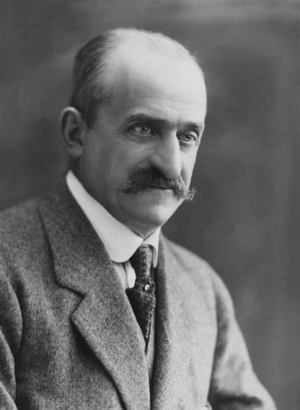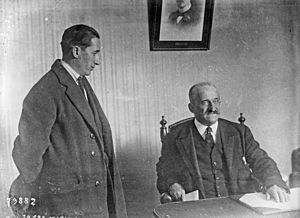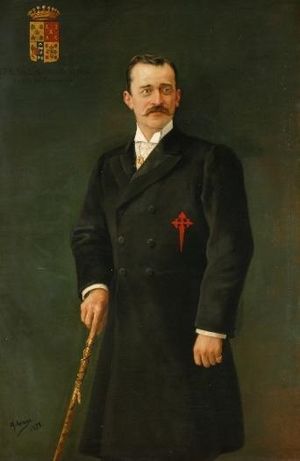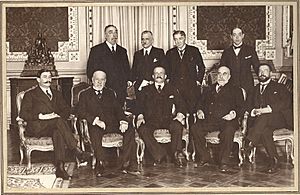Álvaro de Figueroa, 1st Count of Romanones facts for kids
Quick facts for kids
The Count of Romanones
|
|
|---|---|

Portrait by Bassano, 1914
|
|
| Prime Minister of Spain | |
| In office 14 November 1912 – 27 October 1913 |
|
| Monarch | Alfonso XIII |
| Preceded by | Manuel García Prieto |
| Succeeded by | Eduardo Dato |
| In office 5 December 1918 – 14 April 1919 |
|
| Monarch | Alfonso XIII |
| Preceded by | Manuel García y Prieto |
| Succeeded by | Antonio Maura |
| Personal details | |
| Born |
Álvaro de Figueroa y Torres-Sotomayor
15 August 1863 Casa de Cisneros, Madrid, Spain |
| Died | 11 September 1950 (aged 87) Madrid, Spain |
| Political party | Liberal Party |
| Spouse |
Casilda Alonso-Martínez Martín
(1888–1950) |
| Children | 7 |
| Parent |
|
| Alma mater | Central University Collegio di Spagna University of Bologna |
| Signature | |
Álvaro de Figueroa y Torres-Sotomayor, 1st Count of Romanones (born August 9, 1863 – died September 11, 1950) was an important Spanish politician and businessman. He served as Prime Minister three times between 1912 and 1918. He also held many other high-ranking positions. These included being the head of the Spanish Senate and Congress, and even the Mayor of Madrid.
Romanones was a member of the Liberal Party. He was known for building a large political network. He had a strong influence on politics in the province of Guadalajara for many years. He was also a talented writer, creating several history essays.
Contents
Biography
Early Life and Education
Álvaro de Figueroa was born on August 15, 1863, in the Casa de Cisneros in Madrid, Spain. His father, Ignacio Figueroa y Mendieta, was a very rich man who inherited money from mining companies. His mother, Ana de Torres y Romo, came from a noble family. He had four siblings.
When he was a child, Álvaro had an accident with a horse-drawn carriage. This accident broke his right leg and made him limp for the rest of his life. People sometimes made fun of his limp in jokes and cartoons.
He studied Law at the Central University of Madrid and finished in 1884. He then went to the University of Bologna in Italy. There, he earned a special degree in law in 1885. Even with this degree, he never worked as a lawyer.
Starting in Politics
In 1888, Romanones became a member of the Congress of Deputies. This is like being a member of parliament or congress in other countries. He represented the area of Guadalajara. He was elected in a special election to fill an empty seat. He was just under 25 years old, which was the minimum age to be a lawmaker, but he managed to keep this a secret.
Soon after, on September 21, 1888, he married Casilda Alonso Martínez in San Sebastián. She was the daughter of a government minister. They had seven children together.
In 1889, he became a city council member in Madrid. He worked on different city services, like schools and public works. He left this job in 1892.
He was involved in some heated arguments during his political career. In 1892, he had a disagreement with the Mayor of Madrid, which led to a duel. He also had another duel with the Marquis of Valdeiglesias.
In 1894, he was appointed as the Mayor of Madrid. Later, in 1896, he bought a newspaper called El Globo. He changed its focus from supporting a republic to supporting a liberal monarchy. In 1903, he started a new political newspaper called Diario Universal.
Government Roles and Prime Minister
Romanones served as the Minister of Public Instruction and Fine Arts from 1901 to 1902. In this role, he made an important change. He made sure that primary school teachers' salaries were paid by the government, not by local towns. This helped teachers be more independent.
He also served as Minister of Development, Justice, and Interior in later governments. He helped José Canalejas become a top leader in the Liberal Party. As a reward, Romanones became Minister of Public Instruction again in 1909. In 1912, he became the head of the House of Representatives.
After Canalejas was assassinated, Romanones became a very important figure in the Liberal Party. He was appointed Prime Minister for the first time from 1912 to 1913. During this time, he worked with France on a treaty about Morocco.
During World War I, Spain officially stayed neutral. However, Romanones supported France and the Allies. This caused problems with the government and conservative politicians who favored Germany. When he became Prime Minister again from 1915 to 1917, he tried to make Spain's foreign policy closer to the Allies. He even challenged Germany after German submarines attacked Spanish ships. He resigned because he couldn't solve Spain's social problems and faced criticism from the pro-German press.
He later served as Minister of Instruction and Justice in a coalition government in 1918. He also briefly led another government in December 1918. This government faced challenges from independence movements in Catalonia and labor strikes. He left office in April 1919 after introducing the Eight Hour Workday Decree, which set a maximum workday length.
He was Minister of Justice again from 1922 to 1923. In 1923, he became the head of the Senate. He was in this position when Miguel Primo de Rivera took power in a military coup on September 13, 1923.

During Primo de Rivera's dictatorship, Romanones mostly stayed out of politics. However, he was involved in a secret plan against the government, for which he was fined.
In 1931, he became Minister of State in a new government. But elections showed that the monarchy was not popular. Romanones advised King Alfonso XIII to leave Spain. He spoke with the leaders of the new republican government and helped arrange a peaceful transfer of power. This ensured the safety of the royal family.
Later Life
During the Second Spanish Republic, Romanones continued to represent Guadalajara as a deputy.
When the Civil War began, he was in San Sebastián. He managed to cross into France with help from the French ambassador. In 1937, he moved to the side that supported Francisco Franco. He became a strong supporter of Franco. He even signed a report that tried to justify Franco's military uprising in 1936.
After the war, he wrote his life story (memoirs). He also became the president of the Real Academia de Bellas Artes de San Fernando, which is a royal academy for fine arts. He was also a member of other important academies.
He passed away on September 11, 1950, in Madrid.
Works and Views
Romanones was a very active writer. He wrote his memoirs during the Second Republic. He also wrote several biographies and essays about politics.
Even though he was Catholic, he believed in religious freedom. He was against the church having too much influence in government. This often led to disagreements with religious leaders. For example, in 1905, he supported a law that allowed people to get married without declaring their religion. He also strongly supported the idea of keeping the church and state separate.
Honours
Romanones received many honours during his life:
- He earned a special law degree from the University of Bologna.
- He was a member of the Royal Academy of History.
- He was also a member of the Royal Academy of Moral and Political Sciences.
- He was the director of the Real Academia de Bellas Artes de San Fernando.
- He was president of the Ateneo Madrileño, a famous cultural institution.
He was given the title of Count of Romanones in 1893. In 1911, he became a Grandee of Spain, which is a very high noble rank. He also became the 7th Count of Yebes in 1922.
See also
 In Spanish: Conde de Romanones para niños
In Spanish: Conde de Romanones para niños




